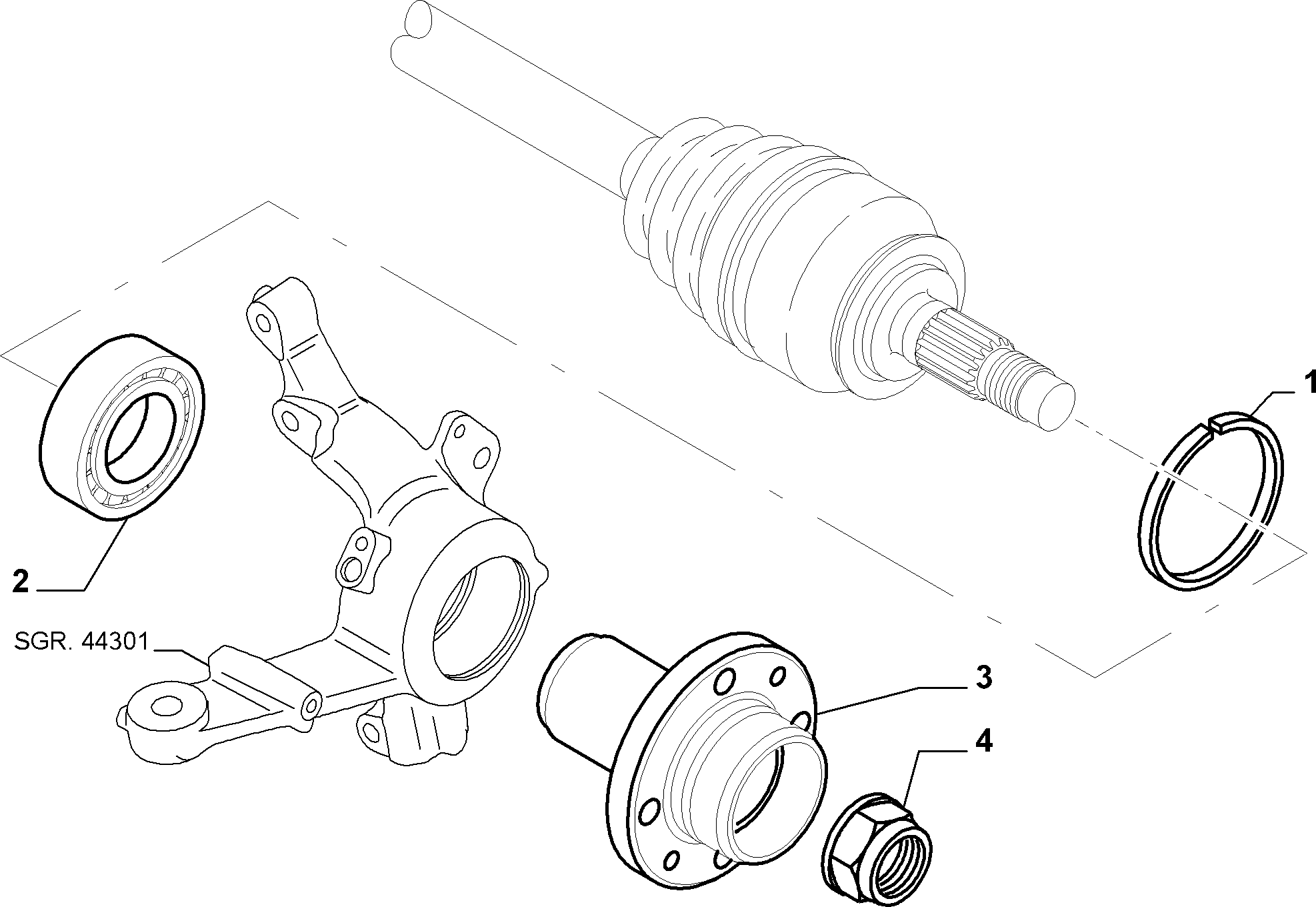I have only ever used anti seize on one engine - a Yamaha bike with 8 valve 900cc air cooled engine. It needed new plugs every 10,000 miles but they were often horrors to remove. I never went to longer lasting plugs as they'd probably never come out. I did use high temperature anti seize but took care to not over-tighten the plugs. Fiats have never been a problem. I use a long plug spanner socket as that gives me the best idea of the correct angle. I have normal sockets and extensions that fit but they flop around, making the plugs easier to get cross threaded.
They taught us to use Copper based grease in college back in the late '60s and it just became a way of life for me. Mind you back in those days the heads were cast iron - except for "exotica" like the Hillman Imp - and we wouldn't have even thought of getting the torque wrench out of the stores to do plugs.
I'm now completely converted to fitting plugs "dry" since I became aware of trivalent coatings etc. I do still treat the classic horticultural stuff to a lick of it though.
Like you I prefer a nice solid installing tool and agree it allows you to be much less likely to cross thread the plug. I find I get on just fine with solid extensions though and wouldn't even think of using a universal joint unless there was no other option.
Oh, another thing with this Panda, I'm going to replace the spark plugs and filters.
What kind of tools am I looking for to do that? Anywhere you'd recommend buying from?
If you look at that video it gives you a pretty good idea of what he's using to do the filters - as you can see, the air filter doesn't actually need any tools, can't be many you can do that to. However the plugs need a little more thought so I thought I'd use this as an excuse to post one of my, possibly boringly long, posts?
The short answer is you'll need a deep socket, ratchet or "T" bar and some extensions of a suitable length to connect the ratchet, or "T" bar to the socket. Maybe worth looking at this in more depth though.
The rubber boots on the plugs may put up a bit of a fight as they tend to "weld" themselves onto the plug ceramics with age and heat. So far I've always managed to get them off with a pair of water pump pliers but I've always fancied a decent pair of boot pliers, like these maybe?
https://www.ebay.co.uk/itm/165624150547?hash=item268ff7fa13:g:688AAOSwGRBi9jAM&amdata=enc:AQAIAAAA4CSwAOPQlrNnzqEDEmVr5XIiJZf4x8WVjLa0dse6oX+CyPagDkA5lvw1KwNQnYaFIvRRKonZQSYt5rTHQ/vu3L6R+xQc8Xnk6zIMjpAINF8lz+TJfjexIbFJGR+wLYPFklLtlQYt5DGLH+MLglNQ15Sxg2lRA8K/WUkM8k/o1vUmWhB0skz9rjGxKqphzkGBMAzQu+o0CpwbiCfsILboWO81AoX6B71IjUqp+k90jDly0Kiknk6PDcphkQlFzupQ8ShBqWzHVykgtMfYjF3VufXrYVyuL2xLSN5pzoX/FBUj|tkp:BFBM5vi1mKJi Just remember to never pull on the wire itself, always pull on the rubber boot.
A lot of cars these days have plugs with a 16mm hex and my preferred "weapon of choice" is this:
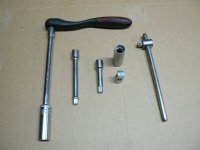
3/8" drive format. The ratchet is a composit material Clarke branded from Machine mart. It's very comfortable to use and doesn't get cold in winter but not so easy to keep clean as the traditional chromed metal type - I like it. The extensions and "T" bar are very old, from the '60's, and probably Gordon brand if I remember (the ratchet was marked but the extensions were not and the ratchet was poor and expired many years ago). The original set just had normal sockets and no plug socket. Back in those days I mostly used 1/2" drive Britool stuff so that didn't matter but one day, in the motor factors, they had a special offer on a 3/8" drive Britool plug socket and I was working on a Bedford CF with the slant 4 engine which had those "notorious" taper seat plugs which were difficult to get to. I bought it and used it quite a lot. In fact it's even marked "For 14mm taper seat plugs" - taper seat was a novelty back in those days! If you look just to the left of the "T" bar you'll see another socket? It's another 16mm deep plug socket but 1/2" drive so to use with the 3/8" format it requires a 3/8 to 1/2" adaptor which is just below it. This one is a magnetic type whereas the Britool is the type with a rubber insert - more on that in a minute. Here's a close up of the writing on the Britool.

Of course there's many other ways to "skin" this particular "cat".
I worked for many years with just 1/2" drive stuff and this job can be easily done with this format albeit that the tools are just a bit more "clumsy". Here's a selection of 1/2" drive stuff alongside the 3/8" for comparison:
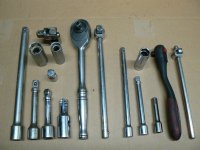
The 3/8" tools can find it difficult to deal with a really tight plug removal which the 1/2" allows you to get "tough" with. Of course there's lots more stuff, like wheel nuts etc, which 3/8" might struggle with so you might like to buy 1/2" drive stuff if you're thinking of getting more involved doing stuff to your car - or just buy both!
As regards the plug sockets themselves, here's a we look at mine:

They mostly come with a rubber insert which is there to hold the plug so it doesn't fall out when positioning it in the threaded hole. The top middle one still has it's but the top right and bottom right do not because, as always seems to happen when they get older, the rubber inserts have fallen out! The two sockets to the left don't have rubber inserts, they have a magnetic ring instead, which can be clearly seen. - Sorry, I forgot to put the 3/8 drive Britool in the picture, it has a rubber insert. In fact the 3/8 socket is a good example of another reason why I don't like the rubber insert type so much, The rubber holds the plug so tightly that the socket stays on the plug and the extension pulls free when you try to remove the tool after tightening the plug! The magnetic type seems to hold the plug nice and secure but not so strongly as to break the extension free so the socket comes out still attached to the extension.
I suppose it might be useful to mention what to definitely not buy? Well here's a picture of some of the slightly weird stuff I've collected over the years:

On the very left is the plug spanner which was in the tool box of the second car i owned, 1936 Morris 8. Obviously wouldn't work on pretty much any modern car I can think of. Next in are a couple of "cheapo" generic jobbies which came from the machine shed when I was a boy and were for lawnmowers and cultivators, again, waste of time for our purposes. The next one is interesting, It's a genuine, French made - says so on it! tool for doing the plugs on the old 504 Peugeot. I did a service on one and had to borrow this tool from the chap working in the next bay to me. Two days later another one came in for service and I landed the job so decided to buy my own. Would you believe it? I never did another! and I had to grind down the end to stop it jamming in the plug'ole! Next to it is a home made attempt at the same tool which wasn't really long enough so you had to use an extension and socket to drive it which then all fell apart as you tried to get it all back out of the hole! Not a big deal. but it slowed you down a lot which cut the bonus! To it's right is a home made thread cleaner. Made from a spark plug with it's ceramic smashed out and the end slotted with a hacksaw then welded to an extension piece for going down long holes. made it for that second 504 which had one "tight" thread and it worked very well. I later bought a proper thread tap but this long tool still comes in useful from time to time. To the right of that is a wee "T" shaped tool which came with a lawn mower or was it a hedge cutter? The small end fitted some of the machine's nuts and it has a flat blade too. It's pretty cheap and nasty however the reason I keep it is that the large socket end is around 19mm so fits some of the weird sized horticultural plugs for the likes of hedgecutters, leaf blowers, brush cutters, etc which I also mess about with.
However, I'm getting a bit carried away with this, so back to our sockets. In my opinion what you need is a 16mm magnetic plug socket. The older cars had plugs with a 21mm hex though, as still do many others, so, when I decided to go with magnetic plug sockets I bought both - and often you'll find deals which include both for not all that much more than just the one. These are my two:
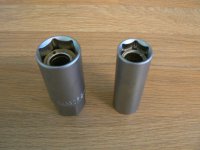
21mm hex size on the left and 16mm on the right (16mm suitable for my 2010 1.2 Panda Dynamic Eco)
By the way, whilst we're thinking about these socket sizes, you're going to find most cars use either 16 or 21 mm hex plugs so you'll cope with most cars you may come across with either one or the other.
The "business" end comes in a bewildering number of variations though:
The way it seals to the head generally falls into either the "crush washer" or "taper seat" type. Here's one of each:
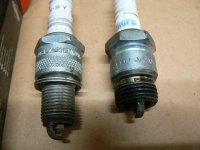
Washer type on the left, taper seat on the right. The crush washer should only be used once as once it's crushed then it's, well, crushed! However we all know you can screw them back in and get away with it. nowadays tightening with a torque wrench, especially with taper seats, is highly recommended but if you've done this for years for your living you get the "feel" for how tight to do them. Don't use antiseize when torquing as it renders the torque wrench setting meaningless and increases the possibility of overtightening and maybe stripping threads or distorting the plug body.
Plugs are very engine specific, especially just of late with these small turbo'ed jobbies. Just look at these two:
They're identical in every way, same thread, same overall insulator length, same hex size, etc. However look at the length of the centre electrodes? The one on the left will project much further into the combustion chamber than the one on the right. The heat build up in them will be very different and if the one on the left were put in the engine intended to take the one on the right then the end electrode might even contact the piston! Plugs are very different. Only ever fit the exact correct plug for the engine.
By the way, here's our "old pals" the washer type and taper seat passing the time of day together with a new plug sitting on top of it's box next to them:
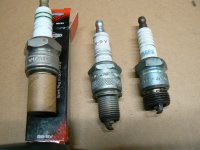
Notice the cardboard tube protecting the electrode end? This is there largely to ensure the side electrode is not subjected to any impact during shipping. Plugs today come ready gapped and if you see this tube in place and undamaged then you can be pretty sure the gap will be spot on - I always visually inspect just in case though. Normal, so called "copper core" plugs, like the ones in the picture above, can have their gap altered if you really need to - maybe at an interim service interval? - by gently bending the side electrode (better to do this with the proper tool rather than knocking it against your workbench as you don't want the electrode being damaged and maybe later dropping off inside the cylinder!) Platinum and Iridium plugs should never be messed with. If the plug gap is incorrect the plug should be returned DON'T BEND THE ELECTRODE and stay well away from the very slim centre electrode which is VERY brittle!
Well, she sun's come out and Mrs J is making a cup of tea and cutting a piece of lovely looking cake so I'm off into the garden to sit on my bench, look at the flowers, drink my tea and get stuck into that caramel cake! I'm sure I've probably forgotten something above so please do feel free to contribute - or criticize as appropriate?
Edit. PS was just thinking, you'll notice my older plug sockets are double hex (12 point) whereas the new, magnetic, ones are single (6 point) jobbies? I like that the new ones are 6 point as it virtually eliminates the possibility of rounding off the corners of the hex shape - although, thinking some more on this, I've had plugs snap off in the head (insulator and centre electrode coming away in the socket and threaded portion left in the head) but never actually rounded off the hex with one of the old 12 point tools.









